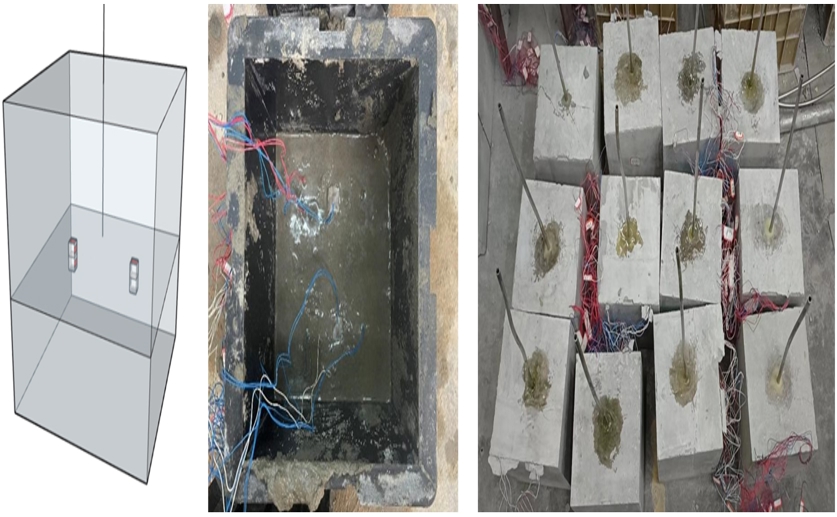Jim Crocker
4th October, 2025

Scientists created these layered sample cubes in the lab, embedding a small sensor between the simulated roof rock and coal seam layers to measure fracture growth during experiments.
Key Findings
- In China’s coal mines, extracting methane gas is difficult due to low permeability, but fracking can create pathways for gas flow
- Larger horizontal stress differences, higher pumping flow rates, and thinner layers between rock and coal promote fractures crossing into the coal seam
- Wider fractures form within the coal seam itself, allowing more particles to keep the cracks open for long-term gas release
Researchers from CHN Energy Shendong Coal Group, China University of Mining and Technology, CHN Energy Shendong Technology Institute, Chongqing University, and Henan Polytechnic University[1] have been investigating this interface behaviour to improve fracking efficiency. Their work focuses on how fractures initiate in the roof rock and then propagate into the coal seam. They used a relatively simple and inexpensive method – embedded strain sensors – to measure the widening of fractures at the rock-coal interface in laboratory samples. These measurements were combined with observations of the fractures themselves and the pressure data from the pumping process.
The study’s findings identify several factors that encourage fractures to successfully cross from the roof rock into the coal seam. A larger horizontal stress difference – meaning a greater disparity in pressure in different directions within the earth – is beneficial. Similarly, higher pumping flow rates and lower coal seam stiffness (modulus) also promote fracture propagation. Crucially, thinner intermediate layers between the roof rock and the coal seam were also found to be advantageous. These findings build upon earlier research which established the importance of in-situ stress in CBM reservoirs[2]. That study, conducted in the Liupanshui coalfield, China, highlighted the significant role of stress in influencing gas adsorption, desorption and transport within coalbeds, and showed a general increase in gas content with depth, alongside a positive correlation between pore pressure and gas content. The current study expands on this by pinpointing how specific stress conditions directly affect fracture behavior.
The research team observed that fractures tended to be wider within the coal seam compared to the roof rock. This is significant because the width of the fracture directly impacts the ability of ‘proppant’ – small particles like sand – to migrate into the crack and keep it open after the pumping pressure is removed. A wider fracture in the coal seam allows for greater proppant transport, improving the long-term permeability of the coalbed. Conversely, the study suggests that the width of fractures in the roof rock can limit the amount of proppant that reaches the coal seam, potentially hindering the overall effectiveness of the fracking process.
The methods used in offer a practical approach to understanding fracture propagation. The use of embedded strain sensors provides real-time data on fracture width, which is difficult to obtain using other techniques. Combining this data with visual observations and pressure measurements offers a comprehensive picture of the fracturing process. This approach is particularly valuable given the complexities of deep coal seam environments, where direct observation is often impossible.
The findings have direct implications for the design of hydraulic fracturing operations. The researchers emphasize the need to carefully consider in-situ stress conditions and the mechanical properties of the coal seam when determining the location of fracturing wells and the appropriate pumping flow rates.[3] also highlighted the benefits of hydraulic fracturing to improve permeability, particularly in deep soft coal seams. That study, using FLAC3D and COMSOL multiphysics software, demonstrated a reduction in peak stress around roadways after fracturing, and a significant increase in permeability, alongside a decrease in the occurrence of dangerous ‘coal cannon’ events. The current study adds to this by identifying the specific parameters that influence fracture propagation, allowing for more targeted and effective fracturing designs.
The work also supports the findings of[2] regarding the importance of understanding the depth-related characteristics of stress and gas content in CBM reservoirs. The “in-situ stress-gas content mode” model proposed in that study provides a framework for understanding the dynamic interactions between stress and gas, which is directly relevant to the success of hydraulic fracturing operations.
AgricultureEcologyPlant Science
References
Main Study
1) Experiment study on the cross-layer propagation characteristics of hydraulic fracturing cracks in coal roof rocks
Published 3rd October, 2025
https://doi.org/10.1371/journal.pone.0331970
Related Studies
Related Articles

